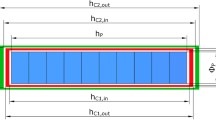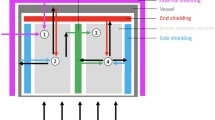Abstract
Neutron self-shielding has been a factor of concern in the history of Instrumental Neutron Activation Analysis. When the sample to be analyzed cannot be made small enough in size and/or sufficiently diluted, this undesired phenomenon must be accounted for. Several analytical, semi-empirical and computational methods for estimating the thermal neutron self-shielding effects have been extensively discussed in the literature and this work aims at the experimental validation of some of these methods by neutron irradiation of cylindrical samples containing strong thermal neutron absorbers. The accuracy and the relative differences in the results between these methods are discussed for cylindrical samples with up to 40% thermal self-shielding, showing that a semi-empirical sigmoidal function can be more accurate in modeling this effect than other exact algorithms, where a maximum 2% relative difference to the experimental values was obtained.

Similar content being viewed by others
References
Case KM, de Hoffmann F, Placzek G (1950) In: Introduction to the theory of neutron diffusion, vol 1. US Govt Printing Office, Washington
Dwork J, Hofmann PL, Hurwitz H, Clancy EF (1955) Report KAPL-1262
Nisle RG (1960) Nucleonics 14(3):86
Stewart JC, Zweifel PF (1959) Prog Nucl Energy Ser 1 3:331
Zweifel PF (1960) Nucleonics 18:174
Wachspress EL (1958) Nucl Sci Eng 3:186
Gilat J, Gurfinkel Y (1963) Nucleonics 21(8):143
Fleming RF (1982) Int J Appl Radiat Isot 33:1263
De Corte F (1987) In: The k 0-standardization method: a move to the optimization of neutron activation analysis. Aggregate Thesis, Gent University, Belgium
Blaauw M (1996) Nucl Sci Eng 124:431
Blaauw M (1995) Nucl Instrum Methods A 356:403
Trkov A, Zerovnik G, Snoj L, Ravnik M (2009) Nucl Instrum Methods A 610(2):553–565
Goncalves IF, Salgado J, Martinho E (2004) Nucl Sci Eng 148(3):426–428
Goncalves IF, Salgado J, Martinho E (2004) J Radioanal Nucl Chem 261(3):637–643
Chilian C et al (2006) Nucl Instrum Methods A 564(2):629–635
Chilean C, St-Pierre J, Kennedy G (2008) J Radioanal Nucl Chem 278(3):745–749
Sears VF (1992) Neutron News 3(3):29–37
NNDC (2010) Evaluated Nuclear Data File (ENDF) Retrieval & Plotting, USA. http://www.nndc.bnl.gov/sigma/index.jsp. Accessed 01 Jan 2011
KAYZERO/SOLCOI® (2003) User’s manual for reactor neutron activation analysis using the k 0-standardization method, Ver. 5a, pp 10–120
IAEA (2009) MATSSF Program. Vienna-Austria. http://www-nds.iaea.org/naa/matssf/. Accessed 10 Aug 2010
Author information
Authors and Affiliations
Corresponding author
Rights and permissions
About this article
Cite this article
Farina Arboccò, F., Vermaercke, P., Sneyers, L. et al. Experimental validation of some thermal neutron self-shielding calculation methods for cylindrical samples in INAA. J Radioanal Nucl Chem 291, 529–534 (2012). https://doi.org/10.1007/s10967-011-1211-y
Received:
Published:
Issue Date:
DOI: https://doi.org/10.1007/s10967-011-1211-y




